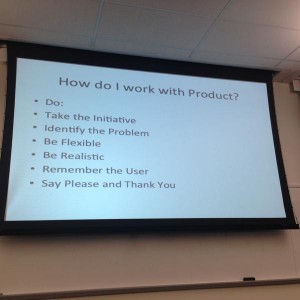 |
| Illustration of Facebook mobile interface (Photo credit: Wikipedia) |
How to be literate in what’s changing journalism
Nov.
9
9
In my ‘digital thinking’ class, the goal is for students to emerge fully literate in the changes affecting journalism. Here are the main currents and trends that I expect them to master by the close of the term.
For each, they should understand: What it means, why it’s important, and where things are going with it. I’ve added a link or two to help get you started. And I’m happy to receive your comments about what’s missing from this list.
1. The social media habit and sharing-as-distribution. As social platforms take greater command of the relationship with users, especially Facebook. (Link.)
3. New business models for news. Beyond the usual method of generating audience to sell subscriptions and ads, including:
* Capturing data… to better target ads and personalize products.
* Selling specialized research… by subscription as Giga Om does or via conversation asTechdirt does.
* Events… leveraging a news brand into convening power. (One link.) (Another.)
* Native advertising and the agency model… The way Buzzfeed and Vice do it. (Link.)
* Non-profit models… as with ProPublica, Minn Post and Texas Tribune. (Link.)
* Crowd funding and membership… as with Beacon, De Correspondent, The Guardian, Voice of San Diego.
* Go it alone… One-person operations can work.
* Selling specialized research… by subscription as Giga Om does or via conversation asTechdirt does.
* Events… leveraging a news brand into convening power. (One link.) (Another.)
* Native advertising and the agency model… The way Buzzfeed and Vice do it. (Link.)
* Non-profit models… as with ProPublica, Minn Post and Texas Tribune. (Link.)
* Crowd funding and membership… as with Beacon, De Correspondent, The Guardian, Voice of San Diego.
* Go it alone… One-person operations can work.
4. Analytics in news production. Learning from audience behavior without becoming enslaved to the numbers. (Link.)
 5. The “product” focus in news companies.Bringing tech, editorial, business and user experience together. (Link.)
5. The “product” focus in news companies.Bringing tech, editorial, business and user experience together. (Link.)
6. Interaction design and improving user experience (UX). Toward an ergonomics for news. (Link.)
7. Data journalism. In all senses: collecting data sets, connecting to data through API’s, data visualization, finding stories in the data, making cleaned-up and searchable databases available to users, sensors in news work. (Link.)
8. Continuous improvement in content management systems and thus in work flow. As an engineering culture takes hold in some news companies. (Link.) (Another.)
9. Structured data. To capture more value from the routine production of news. (One link.) (Another.)
10. Personalization in news products. Why send everyone the same report? (Link.)
11. Transparency and trust. As “trust us, we’re professionals” gives way to “show your work.” (Link.)
12. Open journalism Including: the verification of user-generated content, networked journalism, crowd sourcing, and social media as reporting tool. The people formerly known as the audience in fruitful collaboration with journalists across the production arc— from story idea to sourcing to finished work. (Link.)
13. Automation and “robot journalism.” If machines can do it cheaper and better, human journalists can move up the value chain. (Link.)
14. Creating an agile culture in newsrooms. So that adaptation, collaboration and experiment are not such an ordeal. (Link.)
15. The personal franchise model in news. Based around an individual journalist’s online following. (Link.)
16. News verticals and niche journalism. Doing one thing well and finding a market for it, as the unbundling of omnibus media continues. (Link.)
17. The future of context and explainer journalism. Providing the background needed to understand the updates. (Link.)
18. “News as a service.” Rather than a product appearing on the news company’s schedule, a service that helps a user do something. (Link.)
19. From scarcity to abundance. Used to be that journalists added value by publishing new material. Now they can also serve users by rescuing and organizing the best stuff from a daily flood of cheap content. Sometimes called curation.
20. Fact-checking and rumor control. The press used to deal with false information simply by not letting it through the gate. Now there’s an affirmative duty to track and call out false stories. (Link.) (Another.)
21. “We’re not in charge.” Back then, media companies produced the news and owned the distribution channels. Now other, larger players — platform companies and governments — get in the middle between users and journalists. Journalistic work circulates on sites that editors do not control. The publishers of news have to “go where the people are,” yet they often don’t know what is being done to those people. The public has to be alerted to that. (Link.)
What’s missing? If you know, hit the comment button and let me know.
UPDATE, Nov. 13: Items 19 to 21 came from suggestions I received after this was first published. Also see Steve Buttry’s annotated response to my list. He adds a great many more resources for understanding these changes.
This post has been translated into Italian and Spanish and French. German and Portuguese are on the way, too.
2: The shift to mobile devices and on mobile to apps. Distribution
3: New business models for news. Parsing & distribution
4: Analytics in news production. Distribution
5: The “product” focus in news companies. All three (but still traditional outputs as above)
6: Interaction design and improving user experience (UX). Distribution
7: Data journalism. Parsing
8: Continuous improvement in content management systems and thus in work flow. Parsing
9: Structured data. Parsing
10: Personalization in news products. Distribution
11: Transparency and trust. Distribution
12: User generated content. Gathering (and was my area of speciality at Storyful)
13: Automation and “robot journalism. All three
14: Creating an agile culture in newsrooms. Improvement in processes of all three
15: The personal franchise model in news. Alll three
16: News verticals and niche journalism. Still within existing paradigm
17: The future of context and explainer journalism. Parsing & distribution
18: “News as a service.” A product of sorts, but within current paradigm.
Murdoch –
THAT is it.
Polarized media, direct-from-source spin and just plain false information are increasing.
1. the corrective post, fixing wrong information from elsewhere:http://talkingpointsmemo.com/edblog/breitbart-issues-best-correction-since-forever
2. the political fact check, often difficult to report and write and fraught with consequences:
http://www.wral.com/fact-check-a-500-million-education-that-isn-t-quite-what-it-seems/13935936/
3. the full site with a mission to correct false information:
http://www.emergent.info/
Part of this relates to product and presentation – a 140-character tweet can sometimes serve as a fact check or conversely serve as a way to obfuscate or cherry pick and spin numbers. Knowing what format works best and most efficiently to find and convey truth is a factor – as HF notes in his efforts to sift through a bunch of tweets.
journalism is not only about content, it’s about sales (to advertisers or readers) and distribution.
- Segmentation of digital journalism in different products (Like The New York Times tried to do with NYT Opinion, which didn’t work, and NYT Now, which apparently worked). And consequently:
-Gaming
-Internet of Things
-Streaming media
-Sensory media (e.g., texting smells)
-Wearable technology
http://goo.gl/FOcDOv